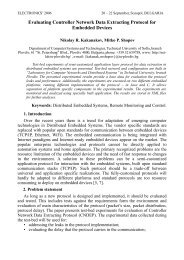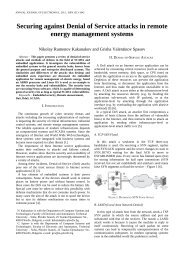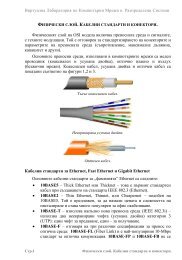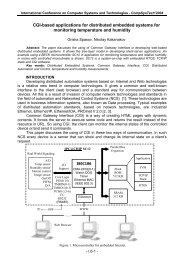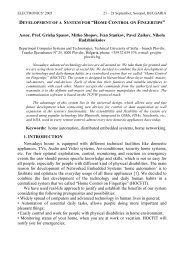SIM300D AT Command Set - Distributed Systems and Networking
SIM300D AT Command Set - Distributed Systems and Networking
SIM300D AT Command Set - Distributed Systems and Networking
Create successful ePaper yourself
Turn your PDF publications into a flip-book with our unique Google optimized e-Paper software.
<strong>SIM300D</strong> <strong>AT</strong> <strong>Comm<strong>and</strong></strong> <strong>Set</strong><br />
Confidential SIMCOM<br />
The character set is defined in GSM specification 07.05.<br />
The character set affects transmission <strong>and</strong> reception of SMS <strong>and</strong> SMS Cell Broadcast messages,<br />
the entry <strong>and</strong> display of phone book entries text field <strong>and</strong> SIM Application Toolkit alpha strings.<br />
1.6 Flow control<br />
Flow control is very important for correct communication between the GSM engine <strong>and</strong> DTE. For<br />
in the case such as a data or fax call, the sending device is transferring data faster than the<br />
receiving side is ready to accept. When the receiving buffer reaches its capacity, the receiving<br />
device should be capable to cause the sending device to pause until it catches up.<br />
There are basically two approaches to achieve data flow control: software flow control <strong>and</strong><br />
hardware flow control. <strong>SIM300D</strong> support both two kinds of flow control.<br />
In Multiplex mode, it is recommended to use the hardware flow control.<br />
1.6.1 Software flow control (XON/XOFF flow control)<br />
Software flow control sends different characters to stop (XOFF, decimal 19) <strong>and</strong> resume (XON,<br />
decimal 17) data flow. It is quite useful in some applications that only use three wires on the serial<br />
interface.<br />
The default flow control approach of <strong>SIM300D</strong> is hardware flow control (RTS/CTS flow control),<br />
to enable software flow control in the DTE interface <strong>and</strong> within GSM engine, type the following<br />
<strong>AT</strong> comm<strong>and</strong>:<br />
<strong>AT</strong>+IFC=1, 1<br />
This setting is stored volatile, for use after restart, <strong>AT</strong>+IFC=1, 1 should be stored to the user<br />
profile with <strong>AT</strong>&W.<br />
Ensure that any communications software package (e.g. ProComm Plus, Hyper terminal or<br />
WinFax Pro) uses software flow control.<br />
NOTE:<br />
Software Flow control should not be used for data calls where binary data will be transmitted or<br />
received (e.g. TCP/IP) as the DTE interface may interpret binary data as flow control characters.<br />
1.6.2 Hardware flow control (RTS/CTS flow control)<br />
Hardware flow control achieves the data flow control by controlling the RTS/CTS line. When the<br />
data transfer should be suspended, the CTS line is set inactive until the transfer from the receiving<br />
buffer has completed. When the receiving buffer is ok to receive more data, CTS goes active once<br />
again.<br />
To achieve hardware flow control, ensure that the RTS/CTS lines are present on your application<br />
platform.<br />
<strong>SIM300D</strong>_<strong>AT</strong>_V1.00 Page 7 of 180



